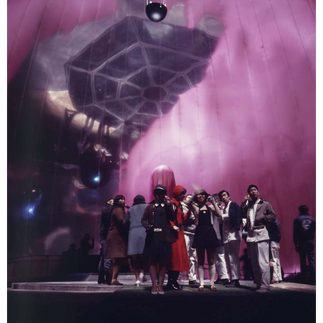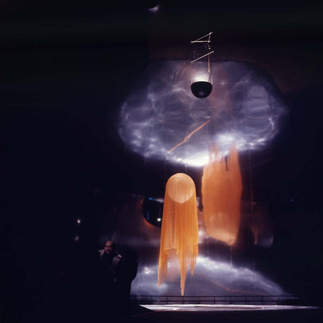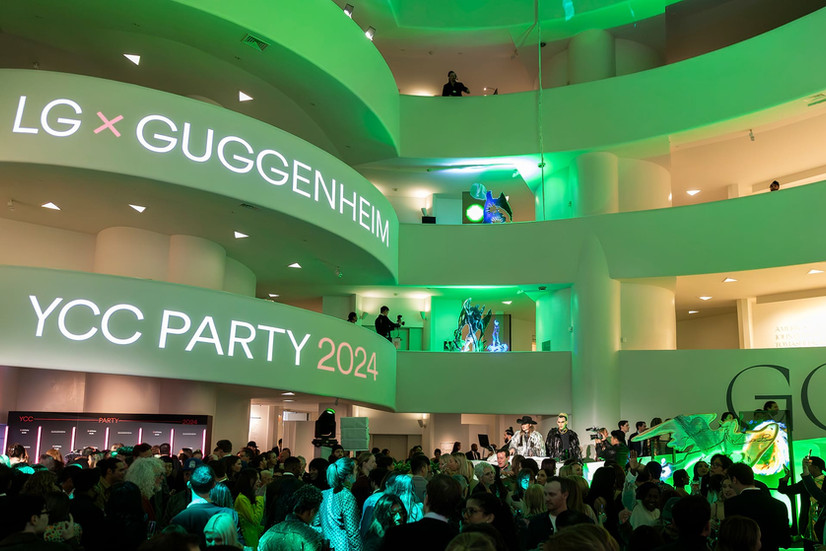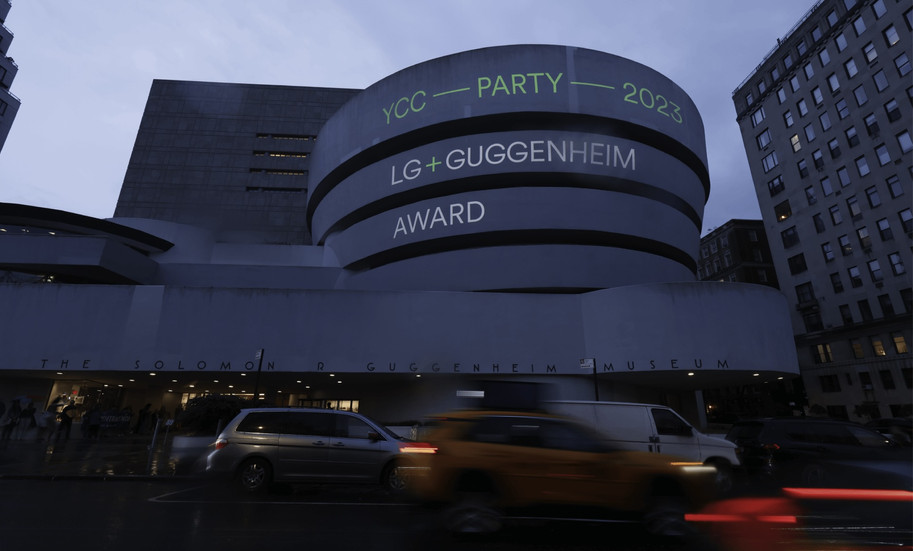[ART in BRANDING] 3. The Corporate Approach: (iii) Technology Augments Art
- CBO Editorial
- Jan 18
- 5 min read
Updated: Jan 23
Technology companies tend to approach art from a fundamentally different perspective than the usual corporate art collections and commissions (think 'lobby art'). Through my extensive work with industry leaders like Microsoft, Intel, and LG, I've come to observe a distinct pattern: these companies aren't interested in art for show of high taste or as an asset class. Instead, they're driven by the possibilities of creative collaboration.
The Art-Tech Intersection: Partners in Creation
When successful technology companies engage with art, several distinctive characteristics emerge. First, there's a notable absence of interest in art collection for its potential market appreciation - any potential returns from the secondary art market would be insignificant compared to their core business revenues. Instead, these companies demonstrate profound curiosity about collaborative art making, often regarding themselves as partners in creation rather than mere financial sponsors.
This attitude, along with corporate-scale resources and proprietary technology, has elevated brands' relationships with art to unprecedented levels of collaboration. The results are often something that would be impossible for individual artists or traditional art institutions to create independently.
Early Pioneers: The E.A.T. Movement
The intersection of art and technology isn't entirely a recent phenomenon. In 1966, a groundbreaking series of performances titled "9 Evenings: Theatre and Engineering" brought together artists and engineers from Bell Laboratories, the longtime research-and-development arm of the American Telephone and Telegraph Company (AT&T) and now part of the Finnish telecommunications company Nokia. This collaboration featured pioneering artists like John Cage and Robert Rauschenberg, introducing unprecedented technologies such as video projection, wireless sound transmission, and Doppler sonar, to the art world.
The significance of "9 Evenings" cannot be overstated. In an era when computer technology was still in its infancy, these performances demonstrated how technology could fundamentally transform artistic expression. For instance, Rauschenberg's "Open Score" used infrared cameras and projection systems to create a revolutionary tennis match performance where the lights dimmed with each strike of the ball, eventually plunging the audience into darkness while infrared projections revealed the continuing performance.
This initiative led to the establishment of Experiments in Art and Technology (E.A.T.) in 1967, a non-profit organization dedicated to fostering artist-engineer collaborations. E.A.T. operated through direct person-to-person contacts between artists and engineers, avoiding bureaucratic processes that might stifle creativity. This approach proved remarkably effective, leading to numerous groundbreaking projects throughout the late 1960s.
E.A.T.'s crowning achievement came with the Pepsi Pavilion at Expo '70 in Osaka, where over 75 artists and engineers created an extraordinary multimedia installation. The project featured a geodesic dome covered in a water vapor cloud sculpture and sophisticated sound systems. The pavilion's mirror room created hologram-like images that seemed to float in space, while its terrace featured kinetic sculptures emitting computer-generated sounds - technological features that were decades ahead of their time.
Shunk-Kender, Harry Shunk, Janos Kender, Robert Breer, Remy Charlip, E.A.T., Nakaya Fujiko, et al.
E.A.T.'s Pepsi Pavilion at Expo '70, Osaka, Japan, 1970 March 18, 1970. | Copyright pending J. Paul Getty Trust
"Collaborative Philanthropy": A New Paradigm
Reflecting on the Pepsi Pavilion from today's brand activation perspective, one crucial element appears missing: brand relevance. While the installation was groundbreaking, the connection between Pepsi's raison d’être and this technological art experiment remains unclear. Perhaps this disconnect partly explains why such elaborate collaborations fell out of fashion in the 1970s.
However, the art-and-technology movement has experienced a remarkable resurgence since the 2000s. In what resembles the Renaissance of Tech-Art Collaboration, initiatives are characterized by broader participation, more sophisticated technological integration, and – crucially – a heightened sense of brand relevance.
Today's collaborations have evolved into what I call "Collaborative Philanthropy" – a model exemplified by initiatives like the Google Art Project (now Google Arts & Culture) and the LG Guggenheim Art and Technology Initiative.
Google Arts & Culture, launched in 2011, took the form of an online platform that leverages Google's Street View technology to document and share high-resolution images of artworks from over 600 museums worldwide so that anyone can "visit" the world's museums any time. The impact of Google Arts & Culture extends beyond mere digitization. Leveraging the proprietary technologies behind Google Search and Maps, the Arts & Culture platform enables virtual museum tours, art exploration by color or theme, and AI-powered features like historical portrait matching. These capabilities transform art appreciation from a passive viewing experience into an interactive, personalized journey. The project perfectly aligns with Google's mission to democratize access to the world's information, while creating unprecedented opportunities for the mass' cultural appreciation.

The LG Guggenheim Art and Technology Initiative
The LG Guggenheim Art and Technology Initiative, which I had the privilege of architecting from conception to launch in 2022, represents a particularly sophisticated example of collaborative philanthropy. This partnership emerged from a shared recognition that technology increasingly serves as both a medium for artistic expression and a bridge between cultural institutions and global audiences.
The initiative brings together LG's technological expertise and the Guggenheim's artistic legacy in several meaningful ways. At its core is the LG Guggenheim Award, which provides substantial funding for artists working at the intersection of technology and art, enabling them to pursue ambitious projects without financial constraints. Complementing this, the partnership established a dedicated curatorial position at the museum focused specifically on art and technology convergence, ensuring ongoing research and development in this vital field.
The collaboration extends beyond traditional museum programming through innovative public engagement. During New York's contemporary art week, the Guggenheim's iconic rotunda transforms into a futuristic nightclub featuring cutting-edge display technologies, creating an environment where young art enthusiasts naturally experience emerging technologies. This marriage of social experience and technological showcase demonstrates how contemporary art institutions can engage new audiences while providing technology brands with meaningful contexts for their innovation.

Further, the partnership transcends physical boundaries by adopting new channels for art distribution. Through LG's OLED TVs, which hold the world's largest market share in their category, curated selections from the Guggenheim's permanent collection reach living rooms worldwide.
In designing this partnership, I recognized its potential to elevate technology-based art from a contemporary phenomenon to an established genre. By institutionalizing the support, curation, and presentation of technology-driven artistic practices through one of the world's preeminent museums, the partnership helps codify what was once seen as experimental or peripheral into a recognized artistic category. The dedicated curatorial position, annual award, and ongoing research programs create a framework that legitimizes and sustains this emerging field, establishing technology not just as a tool for artistic creation but as a fundamental medium of contemporary artistic expression.
The multi-faceted nature of this partnership illustrates how modern tech-art collaborations can simultaneously serve cultural, educational, and commercial objectives. It demonstrates that when technology companies and cultural institutions align their strengths and missions, they can create programs that meaningfully advance both artistic innovation and audience engagement.
Looking Forward
The evolution from traditional corporate art patronage to collaborative philanthropy marks a significant shift in how companies engage with the arts. Technology-driven partnerships create unprecedented opportunities for artistic boundary-pushing while making art more accessible to global audiences. As technology continues to advance, these partnerships will likely play an increasingly crucial role in shaping the future of creative expression and cultural experience.
---
This article is part of the ART IN BRANDING series by Seol Park examining the relationship between visual arts and branding throughout history. The next and final article discusses the bottom line and the ultimate state of art in branding.




























![[ART in BRANDING] 4. The Bottom Line & the Ultimate State](https://static.wixstatic.com/media/fa1d11_1cb3fcbf078e4cbb88a8575ff0b364ed~mv2.jpg/v1/fill/w_720,h_720,al_c,q_85,enc_avif,quality_auto/fa1d11_1cb3fcbf078e4cbb88a8575ff0b364ed~mv2.jpg)
![[ART in BRANDING] 3. The Corporate Approach: (ii) Banking Moves Beyond Collecting](https://static.wixstatic.com/media/fa1d11_870f954605d34d28976879ecc5a7c362~mv2.png/v1/fill/w_720,h_720,al_c,q_90,enc_avif,quality_auto/fa1d11_870f954605d34d28976879ecc5a7c362~mv2.png)
![[ART in BRANDING] 3. The Corporate Approach: (i) Luxury Wears Art](https://static.wixstatic.com/media/fa1d11_a2565113808a4b4ebe197ed88bb8877d~mv2.png/v1/fill/w_720,h_720,al_c,q_90,enc_avif,quality_auto/fa1d11_a2565113808a4b4ebe197ed88bb8877d~mv2.png)
Comments